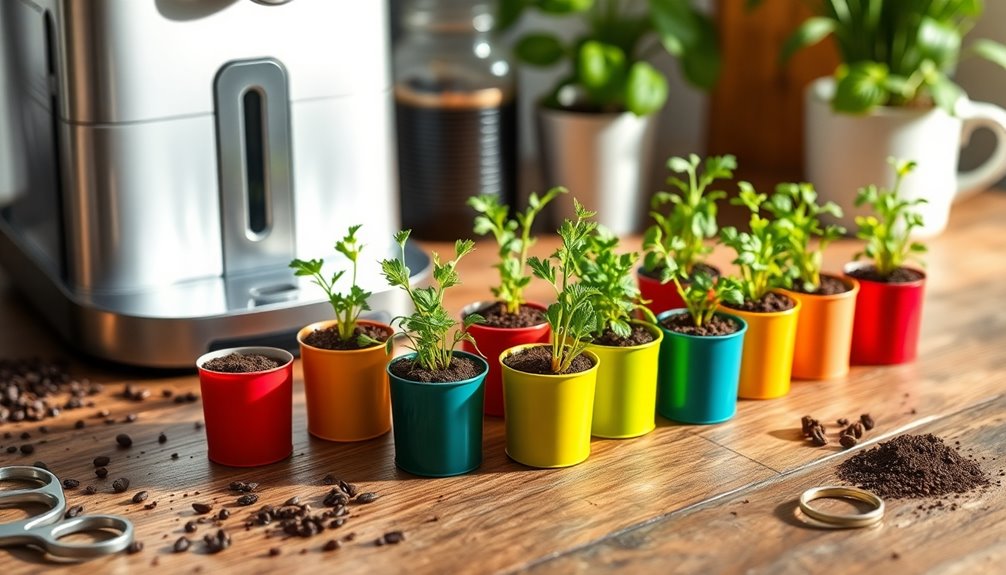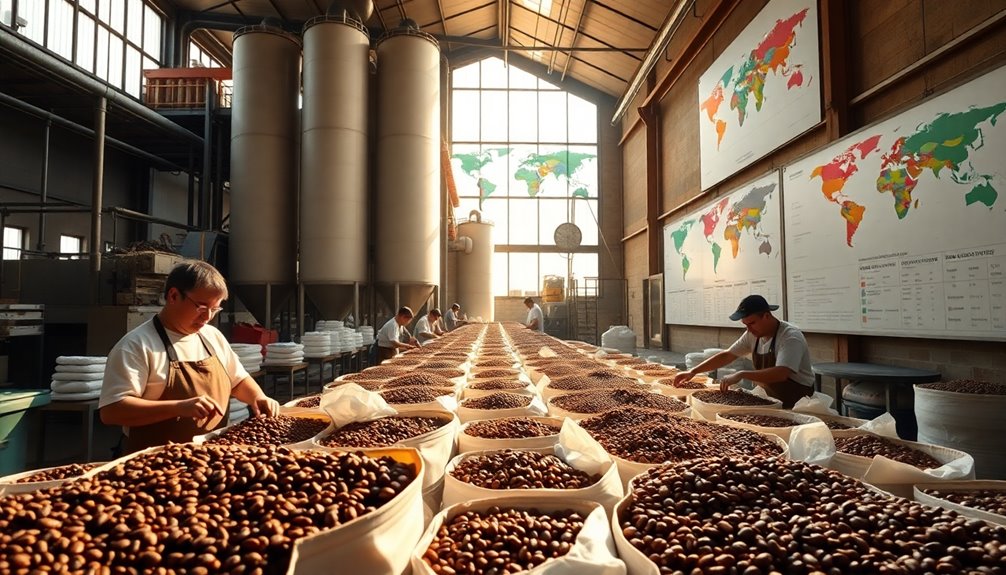When you run an urban coffee roasting operation, you need to follow local zoning laws to keep everything legal and community-friendly. Your equipment must meet air quality standards by using proper filtration and eco-friendly exhaust systems to reduce pollutants. Engaging with your neighborhood through events and collaborations builds trust and shows your commitment to sustainability. Staying compliant helps avoid fines or shutdowns, and maintaining good community ties keeps your business thriving—there’s more to explore if you want to do it right.
Key Takeaways
- Proper zoning ensures coffee roasting operations comply with local land use, noise, and emission regulations, fostering community harmony.
- Regular equipment maintenance and filtration systems reduce emissions and pollutants, improving urban air quality.
- Eco-friendly exhaust methods and emission controls help roasters meet environmental standards and minimize neighborhood pollution.
- Community engagement through educational events and collaborations builds trust and supports sustainable urban coffee practices.
- Compliance with air quality regulations and zoning laws prevents penalties, promotes sustainability, and enhances city-resident relations.

Have you ever wondered how your favorite coffee gets its rich, fresh flavor right in the heart of the city? It all starts with the roasting process, and urban coffee roasters are highly committed to sustainable practices. You might not see it on the surface, but behind the scenes, these roasters carefully manage their equipment maintenance to guarantee every batch is perfect while reducing their environmental impact. Regular maintenance of roasting machines isn’t just about longevity; it’s about efficiency and consistency. When equipment runs smoothly, it burns less fuel and produces fewer emissions, helping to keep the city’s air cleaner. This dedication to sustainable practices isn’t just good for the planet—it also results in a more flavorful, premium-quality coffee for you. By maintaining their equipment properly, roasters prevent the buildup of residues that could compromise flavor or cause unnecessary waste, ensuring every roast is fresh and vibrant. Additionally, proper equipment calibration and color accuracy help maintain consistent roasting profiles, which is essential for delivering high-quality coffee. In an urban setting, zoning plays a critical role in how coffee roasters operate. You might not realize it, but zoning laws are designed to balance the needs of local communities with business growth. Roasters often have to navigate restrictions on noise, emissions, and building use to operate smoothly within city limits. These regulations push roasters to innovate, adopting cleaner, quieter equipment that minimizes disturbances while still delivering top-tier coffee. When urban roasters respect zoning rules, they foster good relationships with neighbors and city officials—creating a more harmonious environment where coffee culture can thrive. Air quality is another essential concern. Roasters know that the fumes and particulates generated during roasting can impact local air conditions. That’s why many invest in advanced filtration systems and eco-friendly exhaust methods. These measures help reduce pollutants released into the atmosphere, aligning with their commitment to sustainability. You, as a coffee lover, benefit from this effort because it means fresher air in your neighborhood and a healthier city overall. Plus, by adhering to air quality standards, roasters avoid costly penalties and potential shutdowns, which keeps their doors open and their beans flowing. Community engagement is equally important. Urban roasters don’t just serve coffee—they become part of the neighborhood fabric. Many organize educational events, collaborate with local artisans, or support sustainability initiatives. This spirit of involvement fosters loyalty and trust, making coffee more than just a product—it becomes a shared experience. When roasters practice maintenance and sustainable procedures, they not only produce better coffee but also demonstrate their commitment to the community’s health and well-being. It’s this balance of zoning compliance, air quality responsibility, and community connection that makes urban coffee roasting a truly enriching experience for everyone involved.
Frequently Asked Questions
How Does Urban Roasting Impact Local Property Values?
Urban roasting can boost local property values by attracting visitors and fostering community pride, creating a positive economic impact. However, it might also cause noise pollution, which could deter some buyers or renters. Your property’s value depends on how well the economic benefits balance against potential drawbacks like noise. If managed properly, urban roasting can enhance neighborhood appeal, but unchecked noise pollution might limit its positive impact.
Are There Specific Zoning Laws for Mobile Coffee Roasters?
Yes, there are specific zoning regulations for mobile coffee roasters. As a mobile vending business, you must adhere to local zoning laws that dictate where you can operate. These laws typically restrict mobile vending to designated areas or require permits. You should check with your city’s zoning department to make certain your mobile coffee roasting aligns with local regulations, avoiding fines or operational disruptions.
What Are the Best Practices for Reducing Emissions During Roasting?
You can reduce emissions during roasting by implementing effective ventilation strategies, which cut particulate matter by up to 90%. Focus on upgrading your exhaust systems, using high-quality filters, and maintaining proper airflow. Regularly inspecting and cleaning equipment also helps. These emission reduction practices not only improve air quality but also guarantee compliance with local regulations, creating a safer environment for your community and a more sustainable roasting operation.
How Do Community Feedback and Protests Influence Zoning Decisions?
Community activism and public consultations play a vital role in shaping zoning decisions. When residents voice concerns or protests, local authorities often reconsider or modify zoning plans to address community needs. Your active participation in public consultations guarantees your voice is heard, potentially influencing decisions about land use and industrial activities. By engaging in community activism, you help promote zoning that balances economic growth with community well-being.
What Are the Health Implications for Residents Near Roasting Facilities?
Imagine a thin veil of smoke drifting over your neighborhood, subtly affecting the air you breathe. Air quality concerns from roasting facilities can lead to respiratory health risks, especially for children and the elderly. Prolonged exposure may cause coughing, asthma, or other breathing issues. It’s vital to monitor emissions and implement safeguards to protect your community’s health, ensuring the air remains clean and safe for everyone living nearby.
Conclusion
As you navigate the world of urban coffee roasting, remember it’s like tending a delicate garden within a bustling cityscape. Balancing zoning, air quality, and community needs is your way of nurturing this vibrant ecosystem. When done thoughtfully, you create a space where rich aromas and strong connections flourish side by side. Embrace the challenge, and you’ll see your passion for coffee bloom into a thriving, harmonious neighborhood treasure.








